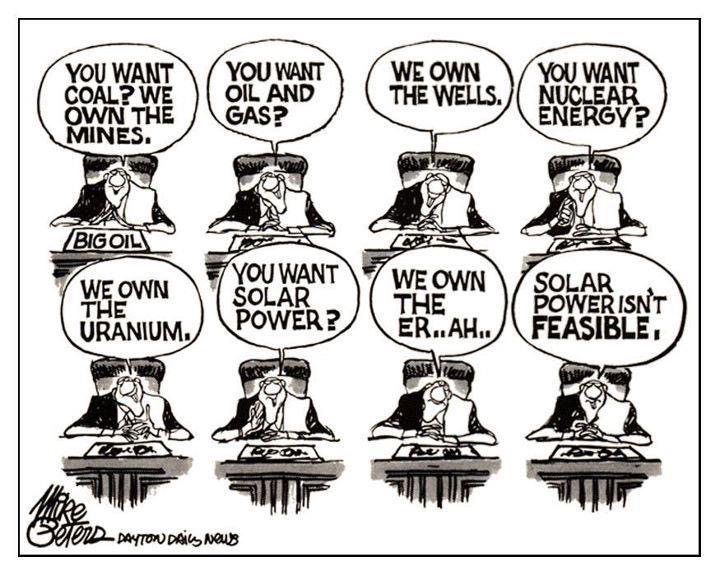- cross-posted to:
- aboringdystopia@lemmy.world
- cross-posted to:
- aboringdystopia@lemmy.world
I saw some context for this, and the short of it is that headline writers want you to hate click on articles.
What the article is actually about is that there’s tons of solar panels now but not enough infrastructure to effectively limit/store/use the power at peak production, and the extra energy in the grid can cause damage. Damage to the extent of people being without power for months.
California had a tax incentive program for solar panels, but not batteries, and because batteries are expensive, they’re in a situation now where so many people put panels on their houses but no batteries to store excess power that they can’t store the power when it surpasses demand, so the state is literally paying companies to run their industrial stoves and stuff just to burn off the excess power to keep the grid from being destroyed.
There is never surplus power with a network of a few “turn it on as needed” intensive industrial uses like haber-bosch reactors for ammonia, dessalination plants and electrolysis for aluminium or other metals…right?
We need natural batteries like solar power lifting water from a lake into a reservoir so that when we need that energy and the sun isn’t making it, released water does
Yes this exists and it’s called pumped storage hydroelectricity
With an energy conversion efficiency of usually 75 to 80 % they are really efficient and don’t have as much energy loss as other types of energy storage. It’s a simple, but powerful concept and I find it beautiful. However, there is some concern regarding their impact on the local ecosystem. Not only do they need huge water reservoirs, which are artificially created and therefore might impact nearby rivers and even fish migration, but the way they are sealed with concrete or asphalt also disallows the development of riparian vegetation. From an ecological perspective they are basically dead zones.
Still, considering several alternatives, I think it’s one of the better options. Although it’s not cheap to build those, which is a problem in our current capitalitic society
Both of the statements in that screenshot are just so inane.
Frequency has to be maintained on the grid. It’s the sole place where we have to match production and consumption EXACTLY. If there’s no battery or pumped storage storage available to store excess energy, the grid operators have to issue charges to the producers, in line with their contracts, to stop them dumping more onto the grid (increasing the frequency). The producers then start paying others to absorb this energy, often on the interconnectors.
It’s a marketplace that works (but is under HEAVY strain because there’s so much intermittent production coming online). When was the last time you had a device burning out because the frequency was too high?
Turning the electricity grid into some kind of allegory about post-scarcity and the ills of capitalism (when in fact it’s a free market that keeps the grid operating well) is just “I is very smart” from some kid sitting in mom and dads basement.
Usually too low frequency is issue, I can’t imagine why even double frequency can damage PSU.
Ok, your particular device may handle a wide band of frequencies. Congrats.
But do we agree that not all devices can? What about sensitive devices keeping patients alive in hospitals?
Those would not be plugged straight into the grid but with a power conditioner inbetween
I get the sentiment in here, but the poster is missing an important point: there is a reason some group of lunatics (called the TSO or Transport System Operator or in some cases other power producers) are willing to pay for people to consume electricity when there is too much of it; They are not doing it for the sake of being lunatics, the electrical system cannot handle over or underproduction. Perfectly balanced (as all things should be) is the only way the grid can exist.
The production capacity in the grid needs to be as big as peak demand. The challenge we face with most renewables is that their production is fickly. For a true solarpunk future, the demand side needs to be flexible and there need to be energy storages to balance the production (and still, in cold and dark environments other solutions are needed).
In off-grid, local usages we usually see this happen naturally. We conserve power on cloudy low-wind days to make sure we have enough to run during the night (demand side flexibility) and almost everyone has a suitably sized battery to last the night. The price variability is one (flawed) mechanism to make this happen on a grid or bidding zone level.
Could they not just install a series of big “resistors” that can be switched on and off to burn off overproduction when necessary?
Those still have to be connected to the grid. be maintained, cooled, controlled, all of which costs money.
My favorite solution for storage of excess power is closed loop pumped hydro. Two bodies of water of different elevations are connected by a generator/pump. When there is too much power, the pump moves the water to the higher lake. When the power is needed, the water flows through the generator to the lower lake.
You may be interested in gravity storage. Giant crane picking up giant concrete legos. Neat concept, there’s been some pilots.

We own the factories building the panels.
Solar cells don’t really grow on trees.
Solar cells don’t really grow on trees.

Are you talking about
A scalable self replicating and self sustaining carbon capture technology that uses a mix of highly specialized biological processes to turn CO2 into engineering grade composite construction material, fuel and fertilizer.
?
You can’t earn the big money with it, so the capitalism isn’t interested. Planting a tree is almost for free. Maybe if we could file a patent on trees or something like that. Let’s ask Nestlé how they did it with water






